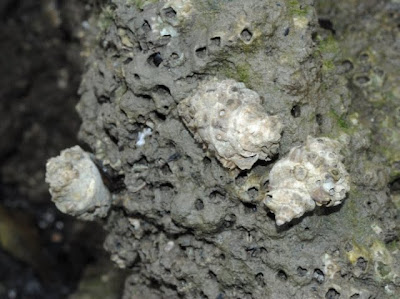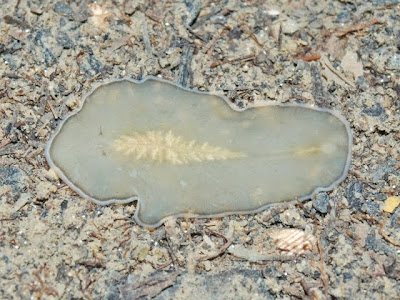After a few visits of Seletar, finally I'm here at Seletar shore for my first time to see what kind of marine life thrives in the sand and mudflat.
The shore is in front of the dam cutting Johor Straits and lower Seletar Reservoir. Quite a large expanse of the shore is exposed! On the right is a bridge that links to Pulau Punggol.
There are mangroves at the back of the shore facing Seletar as well as on the other side at Khatib Bongsu. It is interesting to know that there are some forms of kampong houses and structures that still exist.
There are quite a number of logs and wedged in between crevices are many snails!
On another log, this lone pale green snail is probably the Black-mouth mangrove periwinkle snail (Littoraria melanostoma). We have seen them at Kranji the day before too.
There were quite a number of these blob-like anemones on dead logs. Not too sure what they are exactly since the tentacles were tucked into their body column when out of water.
The logs and loose rocks are home to Drills (Family Muricidae) on top of the usual large number barnacles.
The crabs in this shore are extremely shore. Most of the small Thunder crabs (Myomenippe hardwickii) hide in dark corners.
How about the muddy and soft parts of the shore? It was not easy moving about. As you can see here, James is having a mud spa therapy!
Despite looking yucky and boring from far, there are still some marine life that likes this kind of habitat.
Among the most abundant will be these Striped bead anemones.

They are literally everywhere on the shore! However, these nems are rather translucent in colour which makes spotting them hard and we might have accidentally stepped on a few. Opps.
There were a few individuals of the Striped bead anemones that are not white or translucent like this blackish anemone.
On certain locations of the shore, there are quite a lot of creeper snails!
Also dotting the mudflat and soft shore are many of these Whelks (Family Nassariidae). They have a long siphon that is used to detect chemicals released by dead animals.
And here they are congregating on this dead crab happily feasting away!
Looking closer on these snails, you will soon realize there are many anemones on the shells of these whelks. These anemones can help the whelks defend against predators since nems are able to sting.
Here is the anemone species that we usually see on the shells, but this individual is found on the sand. It has a dark black band across its oral disk.
Furthermore, I also came across some other blob anemones that I've no idea what their identities are.
Among the bivalves, there were many dead shells and I only saw this living clam throughout the trip.
The soft substrate is a great place for worms to wiggle in and out like this pinkish worm.
There's this other worm that I'm not sure what it is exactly.
But this following worm is definitely the top find of the day! A new mangrovey-looking flatworm that I've not seen before. It looks quite pretty!
The underside of this flatworm is much more white than its beige upperside.
All too soon, we had to cut short the trip as the skies were getting dark with lots of lightnings coming from the east side.
It was nice having some friends to be around in this muddy affair. Hope they had fun in the mud as much as I did. Hehe!
Thursday, January 6, 2011
A brief look at Seletar shore
Subscribe to:
Post Comments (Atom)



























No comments:
Post a Comment